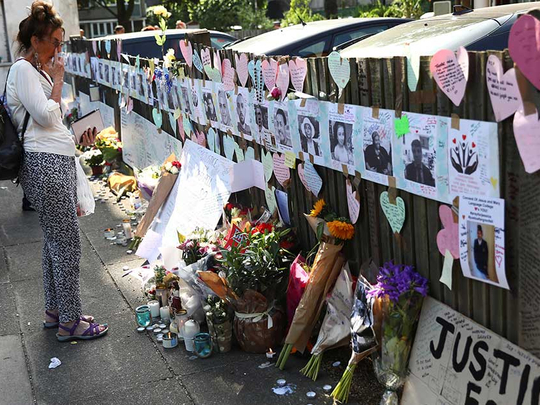
London: Damning new evidence has emerged of ministers’ failure to take steps to improve tower block safety after a series of fatal fires.
Despite repeated calls for sprinklers to be retrofitted in high-rise blocks by coroners and by local fire and rescue services, ministers did not compel social housing providers to do so.
The Department of Communities and Local Government says it set out its view on sprinklers in a letter sent to social housing providers in the aftermath of two tower block fires in which four firefighters and a resident died, but have so far declined to make that letter public.
The first formal warning known to have been issued by a coroner came in February 2013, when Keith Wiseman, the coroner for Southampton, recommended that sprinklers be fitted to all buildings higher than 30 metres (98ft).
Wiseman made that call after a blaze in 2010 at Shirley Towers, a 15-storey block in Southampton, during which firefighters Alan Bannon and James Shears died.
In a letter to Eric Pickles, then communities and local government secretary, and to Sir Ken Knight, then the government’s chief fire and rescue adviser, Wiseman said that “obvious precautions to prevent the fire occurring were not taken” and highlighted the need for sprinklers in high-rise blocks. The following month, Judge Frances Kirkham, the coroner at the inquest into the deaths of six people at Lakanal House in Camberwell, south East London, made a similar recommendation to Pickles.
In a previous report into the Lakanal House blaze, Knight had said that while sprinklers were known to be effective, it was not considered “practical or economically viable” to enforce their retrofitting in high-rise blocks.
However, Kirkham said the evidence she had heard during the inquest “indicated that retrofitting of sprinkler systems in high-rise residential buildings might now be possible at lower cost than had previously been thought to be the case, and with modest disruption to residents”. Both coroners made their recommendations as alerts known as rule 43 reports, which are issued in an attempt to prevent deaths.
A previous call for sprinklers to be retrofitted to tower blocks had already been made after a fatal blaze in February 2005 at Harrow Court, a 17-storey block in Stevenage, Hertfordshire.
Two firefighters, Michael Millar and Jeff Wornham, died along with a resident, Natalie Close, 32, whom they were attempting to rescue. A report by Hertfordshire Fire and Rescue Service subsequently recommended the UK Fire Service should explore the provision of sprinklers for high-rise buildings. It is unclear what action the government has taken in response to the coroners’ calls for the fitting of sprinkler systems.
In his reply to Kirkham, in an undated letter which is thought to have been sent in May 2013, Pickles said the government provided local government with funding to develop guidance on the management of risk in tower blocks. “The housing sector’s feedback on the impact of this guidance has been very positive, and I consider that it addresses sufficiently those issues that have been highlighted in your rule 43 reports,” Pickles wrote. However, he added the department is “not complacent”, and it would be considering whether “a revised document” was needed.
On the specific call for the fitting of sprinklers, Pickles referred Kirkham to a letter that his officials had sent to social housing companies following the deaths of the two firefighters in Southampton.
The Department for Communities and Local Government said it would not be making the letter public. Currently, only buildings erected after 2007 and more than 30 metres (98ft) high are required to be fitted with sprinkler systems.
While some local authorities have been retrofitting sprinklers to some of their blocks, the main obstacle is clearly the cost, although no detailed research appears to have been conducted to establish how great this would be. The British Automatic Fire Sprinkler Association estimates that the cost of fitting a system in Grenfell Tower would have been around GBP200,000. Previously, the association found that fitting a system to 47 flats in Callow Mount, a 13-storey block in Sheffield, South Yorkshire, came to GBP55,000, or GBP1,150 per flat.












